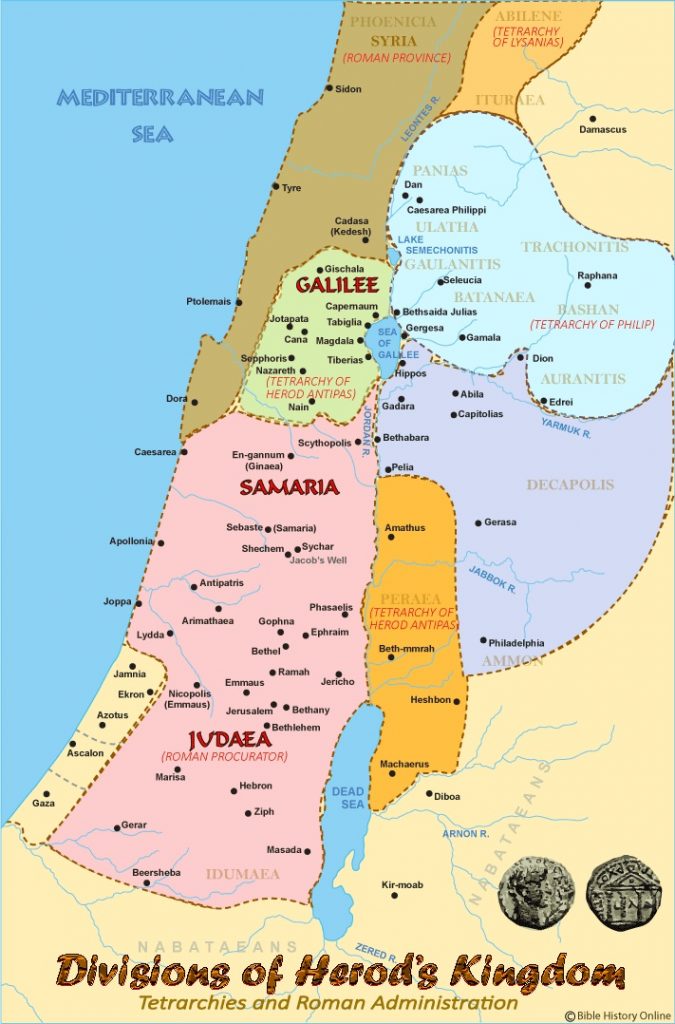Diving In Session 4 Covenant 6 The Land Covenant – Historical overview (OT)
Brief History of the Promised Land in the Old Testament
Last week, we looked at the land promised by God to Abraham (blue and purple shaded) and what parts of it have been actually occupied by Israel over the centuries (blue shaded):
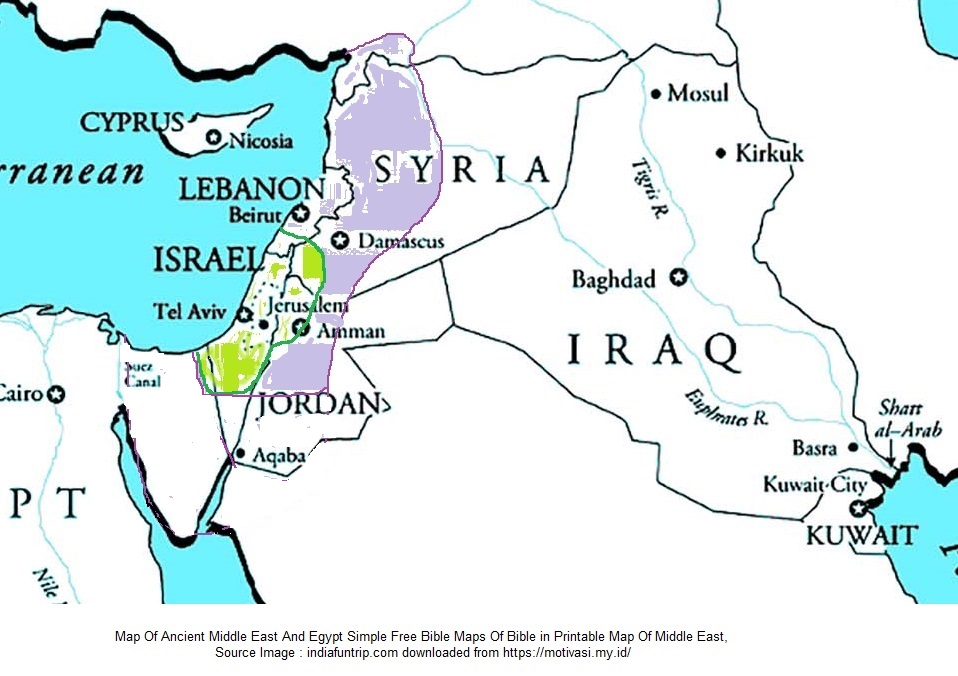
Compare what was promised to the Jews by Balfour, the British Government and the San Remo conference 1917-1923:
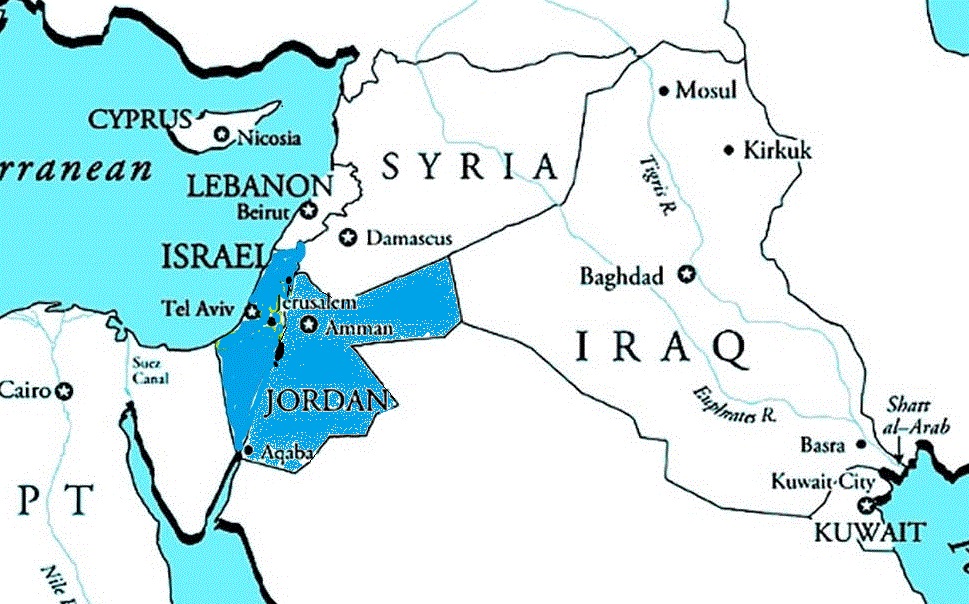
As it is today (blue = Israel; green = Palestinian territory):
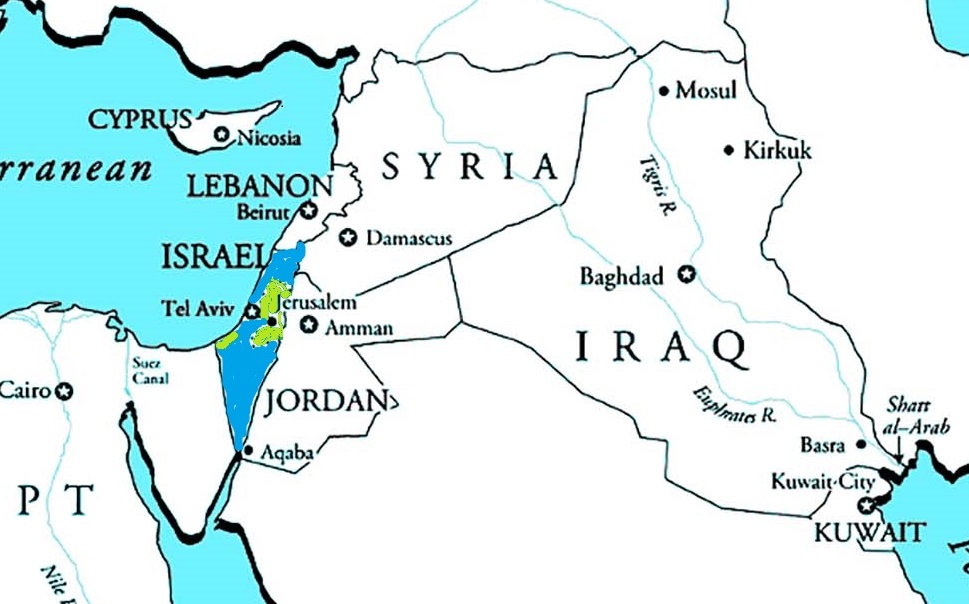
We are looking at the Land Covenant in Deut. 29-30 and how this worked out for the Children of Israel over the next two sessions. This week, we look at Biblical history and next week, we will look at modern history. It is important to remember (from last week) that the title to the Land is unconditional and depends on the Covenant God made with Abraham, but their actual occupation of the Land depends on their obedience to the terms of the Mosaic Covenant.
Also important to note that the Land is the Lord’s (Lev. 25:33) and He takes a keen interest in what goes on in that Land. The Canaanites were to be evicted due to their idolatrous practices (Lev. 18:24), and Israel was warned that, if they copied the Canaanite practices, the Land would spue them out too (Lev. 18:28; 20:22)
In this context, last week we looked at the three dispossessions and restorations prophesied in the Bible:
- Gen. 15:13-16 wandering in Canaan 215 years, then in Egypt 215 years
- Jer. 25:11-12 in Babylon 70 years
- Deut. 28:62-65; Deut. 30:1-3 started AD70, still waiting for restoration
We saw that two dispossessions and restorations – Egyptian slavery and Babylonian Captivity – have been accomplished. Israel is now in the third dispersion, from which she is being, and will be fully, restored (Isa. 11:11) at the return of the Lord as King under the Davidic Covenant
The Bible reveals that God has determined where the nations should live and when (Acts 17:26; Deut. 32:8-9) and His Will is being, and will be, done regardless of the councils of men and UN resolutions! Today, we will look at Daniel ch. 2, where God gives Nebuchadnezzar, King of Babylon, an insight as to the succession of Kingdoms that will rule the Promised Land until Messiah establishes His Kingdom. But first, we need to what had happened between the Exodus and the Babylonian captivity, and how it affected the land promised to Abraham.
Conquest to Captivity
From the time of the Conquest, c. 1400 BC, the Children of Israel took possession of the land to varying degrees. Joshua records the initial conquest, but Judges 2:17-36 records just how much they didn’t possess and the misery and problems that caused for them.
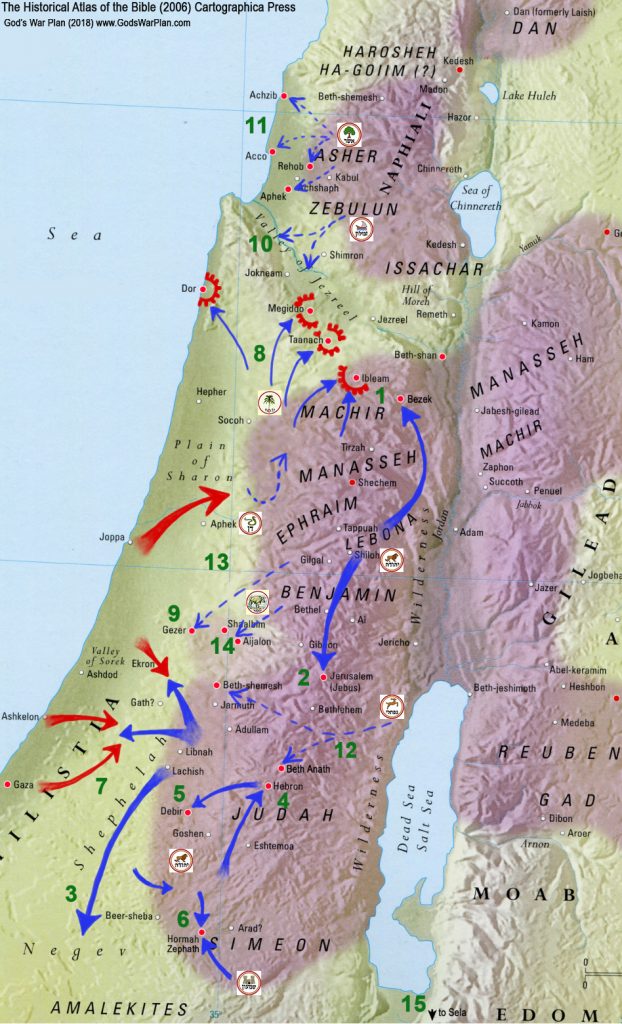
By the time of Saul and David, they were getting more established, but the Philistines in the south west (Gaza strip) and their neighbours on the east of the Jordan and to the south (Ammon, Moab & Edom) were still major problems. Under King David, the Philistines were subdued, and the Moabites paid tribute.
After Solomon, the northern 10 tribes rejected Rehoboam (1 Kings 11:31-33; 12:24) and became an independent kingdom with their own idolatrous worship centres, often at war with their Southern brethren in Judah. Various alliances were tried by both sides – Judah with Egypt, and Israel with Assyria – all recorded in 1 & 2 Kings and 2 Chronicles.
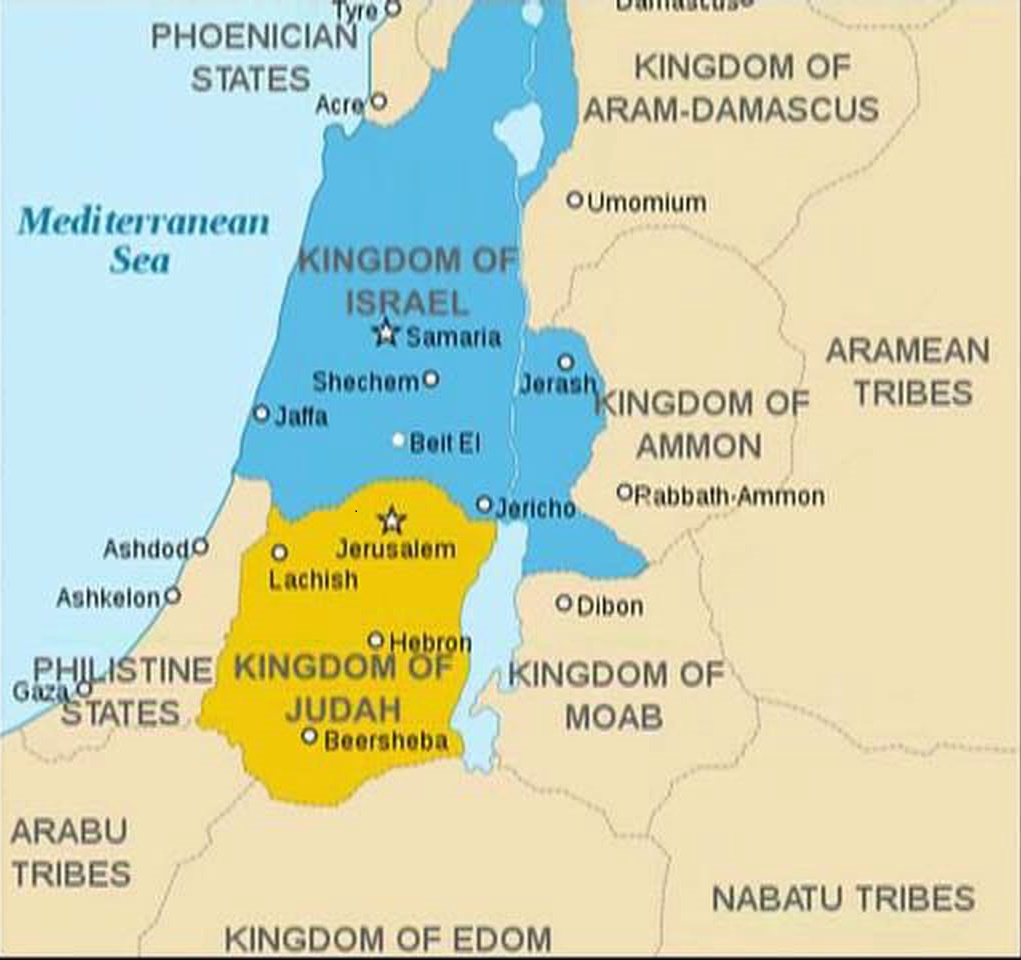
Around 711BC, after many warnings from the Prophets Hosea, Amos, Micah, Isaiah that their idolatry would result in invasion and captivity, the northern kingdom was invaded by Assyria and the people deported 2 Kings 17:18-23. The Assyrians imported people for other parts of their empire, who became the forerunners of the Samaritans (2 Kings 17:24-41).
The Middle East was then dominated by the Assyrian empire and looked like this:
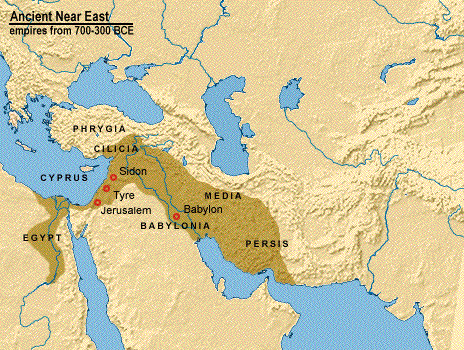
Ultimately, Judah also ignored the warnings from the Prophets (Isaiah, Micah, Zephaniah, Jeremiah) and was taken into captivity. But there had been a massive shakeup in the geo-political structure of the Middle East – Babylon had become a political and military power and overthrown the Assyrians, the Babylonian forces under Nabopolassar (with the help of the Medes) capturing Nineveh in 612BC, and his son, Nebuchadnezzar, the last Assyrian stronghold of Harran in 609BC.
In the meantime, the Egyptian Pharaoh, seeing instability in Judah, and probably to create a buffer between Egypt and the nascent Babylonians, installed a new king, Jehoiakim, who was to rule Judah on his behalf (610BC). However, Jehoiakim rapidly changed allegiance to the Babylonians in 606BC, when Nebuchadnezzar invaded Judah and took Jerusalem. He took the leading people, including Daniel and his three friends, captive to Babylon.
The Babylonian empire then looked like this (note Media and Persia weren’t included):
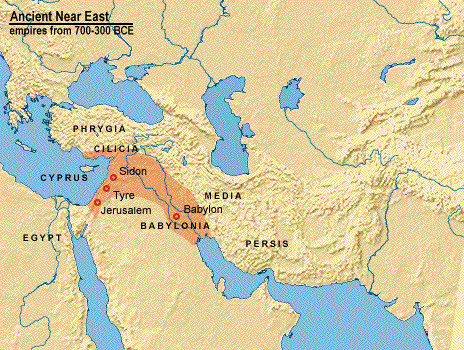
3 years later, Jehoiakim revolted against Nebuchadnezzar. About the same time, Nebuchadnezzar had a dream, interpreted by one of the young captives and we’ll look at that in a minute. In 597BC, Nebuchadnezzar returned to Jerusalem and installed his own puppet king, Zedekiah, taking some more of the people captive to Babylon (possibly Ezekiel this time).
11years later, in 586BC, in response to Zedekiah’s rebellion and league with Egypt, he returned again, besieged Jerusalem and, having captured the city, destroyed the Temple on 9th Ab, and took most of the remaining people captive, leaving the poorest in the land (2 Chron. 36:15-21). Thus begins ‘the times of the Gentiles’, which is covered in Nebuchadnezzar’s dream.
Why all these wars and deportations? Because of the terms of the Land Covenant! Deut. 29:22-28; Josh. 23:16; Judges 2:1-3, 20-22; Psa. 78:55-58; 106:34-40; Ezra 9:10-13; Neh. 9:24-30, 34-36; Dan. 9:11-16
Nebuchadnezzar’s Dream – the Times of the Gentiles (586BC, to 1967AD or even today?)
READ Daniel 2:31-46 (NB 1 Pet. 1:10!)
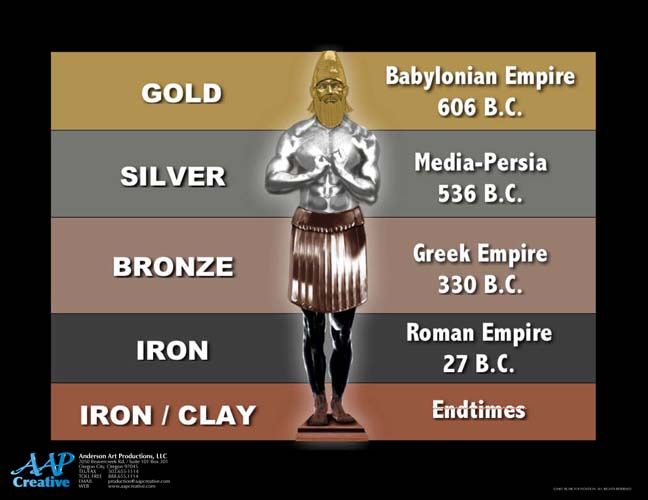
v.37-38 Head of gold – Nebuchadnezzar
v.39a Breast and arms of silver – Medes and Persians (followed the Babylonians) seen in the two arms
v.39b Belly and thighs of bronze – Greece (followed the Medes and Persians)
v.40 Legs of iron – Rome. The Roman Empire was founded when Augustus Caesar proclaimed himself the first emperor of Rome in 31BC and came to an end with the fall of Constantinople in 1453AD. (Some see the East and West divisions of the Roman Empire in the two legs.)
v.41-43 Feet of iron and clay – end of Rome, or successor to Rome? Islam dominated the eastern Roman Empire (the Byzantine empire) with the fall of Constantinople in AD 1453. Islam is also in two divisions= Sunni and Shia (more on this later)
v.44-45 Messiah’s Kingdom which starts with the end of “The Times of the Gentiles” (Luke 21:24)
v.44 “In the days of those kings”, i.e. the ones after Babylon as he’s addressing Nebuchadnezzar and therefore contrasting ‘those kings’ with the king he’s talking to – their influence is still felt today:
- Medes and Persians = Iran which is behind a lot of the conflict in the world today
- Greece = The Enlightenment and Renaissance (EU claims to be founded on Hellenism)
- Rome = Catholic Church which controlled most of Europe’s monarchs from the fall of Rome, and has never lost its political aspirations
‘those kings’ could also refer to the ten toes as representing 10 kingdoms in the divided kingdom of the last days
So what happened after Babylon?
536BC Medo-Persia conquers Babylon
Cyrus’s army conquers Babylon (night of Belshazzar’s Feast!) and takes control of the Babylonian empire, eventually covering a huge swathe of the Middle East:
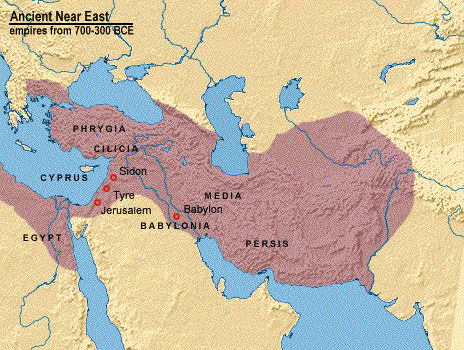
Cyrus makes a declaration that all Israelites who want to, can return to their homeland. Three groups return – under Zerubbabel 536BC (with the rededication of the Temple in 515BC), under Ezra in 457BC and then under Nehemiah in 446BC (with the completion of the walls of Jerusalem the following year).
During this period, the Medo-Persian power was warring against the Greek states from 499BC ending with a stalemate in 451BC with both sides living in an uneasy truce. Various skirmishes occurred until 336 BC, when Alexander the Great came to power in Macedon and spent the next ten years conquering the Persian Empire and much of Western Asia and Egypt. By the age of 30, Alexander had created one of the largest empires in history, stretching from Greece to northwestern India. He was undefeated in battle and is widely considered to be one of history’s greatest and most successful military commanders.
Greek empire at its greatest extent

After Alexander’s death in 323 BC, the Macedonian Empire disintegrated under widespread civil wars, as predicted in Daniel ch. 11 (see David Pawson’s detailed unpacking of this chapter and the related history in ‘Unlocking the Bible’).
This resulted in a 4-way division of the Greek Empire:
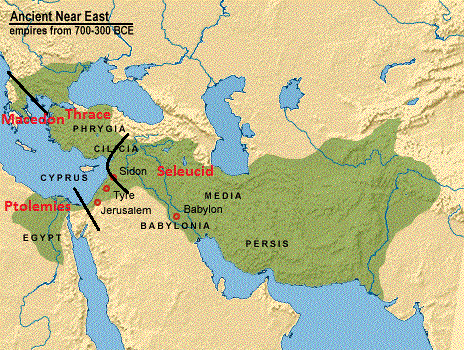
The Seleucids and the Ptolemies were constantly at war with each other, and particularly fought over the land of Israel, as foretold in Dan. 11. Interestingly, this division of geo-political powers is reflected in the current split between Sunni and Shia Islam, also predicted in Daniel 11 to occur in the end times, and which could not have happened until the fall of the Ottoman Empire after WW1 – something we considered in Spiritual Warfare when looking at Territorial Spirits, and will look at next week when considering the history of the land up to the present day.
In the early 2nd century BC, the king of the Seleucids, Antiochus Epiphanies, was defeated by the Ptolemies and took his anger out on Judea on his was home. He was particularly anti-Jewish and tried to stamp out Judaism, burning Torah scrolls and banning circumcision, ultimately desecrating the Temple in 188BC by sacrificing a sow on the great altar of the temple and spraying pigs blood all over the sanctuary, then erecting a statue to Jupiter (foretold in Daniel as ‘the abomination of which makes desolate’ – a preview of the ‘desolation of abomination’ prophesied by Jesus in Matt. 24 and Mark 13).
In the hill country of Judea, one of his officers was officiating at a pagan sacrifice and called for a Jew to come and kill the animal. This was too much for one old man, Mattathias, who came forward and took the sword and killed the officer. That started a revolt under his 4 sons – the Maccabees (hammerer). Within 3 years, they had all but cleared Judea of Antiochus’ forces, and rededicated the temple on 25 Kislev 185BC.
Judea became an independent state for about 120 years (185BC to 63BC) under a dynasty known as the Hasmonean Dynasty, founded in 141BC by Simon Thassi, brother of Judas Maccabeus.
Around 110BC, Judea conquered Edom (Idumea) and forced the Edomites to convert to Judaism. The Edomites were gradually integrated into the Judean nation, and some of them reached high-ranking positions.
The Hasmoneans regained most of the Land during their reign but their kings were considered usurpers as they were not from David’s line. It’s during this time that the factions we know in the New Testament started to appear – the Sadducees with the Temple and the political clout, the Pharisees distancing themselves and trying to remain faithful to the Torah, the Zealots zealous for independence and Davidic rule (and, although not mentioned directly in the New Testament, the Essenes, who thought the whole system was corrupt and went off to the desert to love a pure life and wait for Righteous Prince to come and defeat the Darkness).
The Hasmonean kingdom at its fullest extent:
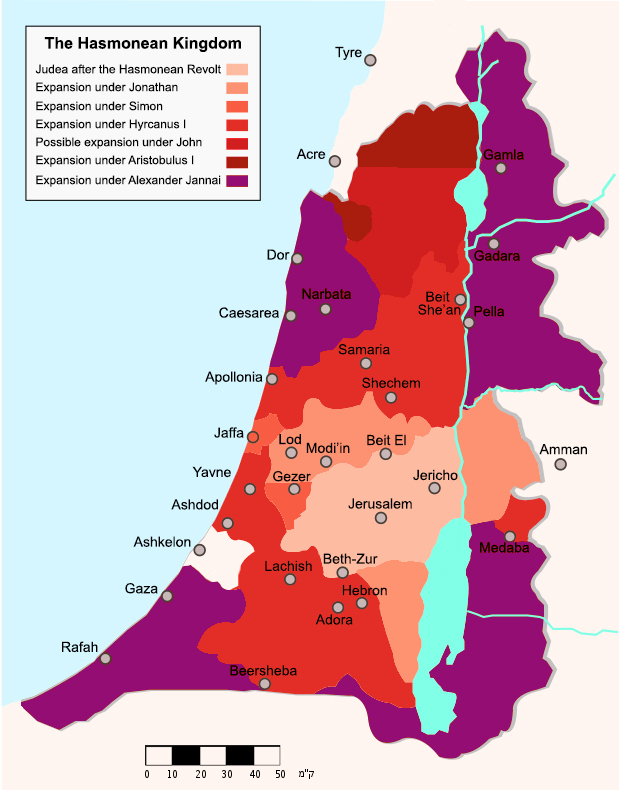
By Effib – https://he.wikipedia.org/wiki/ממלכת_החשמונאים#/media/File:Map_Hasmonean_Kingdom-he.svg, CC BY-SA 4.0, https://commons.wikimedia.org/w/index.php?curid=63408877
The Edomite Antipas was appointed governor of Edom. His son Antipater, father of Herod the Great, was the chief adviser to the last Hasmonean Hyrcanus II and managed to establish a good relationship with the Roman Republic, who at that time (63 BC) extended their influence over the region, following conquest of Syria and intervention in a civil war in Judea. There was a long-running dispute between the two families claiming the Priesthood. Hyrcanus called in support from the Romans to help settle the dispute and civil war that had resulted. Pompey came to their help in 63BC, decided that he needed to take control and annexed Judea as a Roman province, administered by Procurators.
Antipater was appointed Procurator of Judea in 47BC, and appointed his sons, Phasael and Herod, to be governors of Jerusalem and Galilee respectively. Antipater was murdered in 43 BC; however, his sons managed to hold the reins of power and were elevated to the rank of tetrarchs in 41 BC by Mark Antony
In 40 BC, the Parthians invaded the eastern Roman provinces and managed to drive the Romans out of many areas. In Judea, the Hasmonean dynasty was restored under king Antigonus II Mattathias as a pro-Parthian monarch. Herod the Great, the son of Antipater managed to escape to Rome. After convincing the Roman Senate of his sincere intentions in favour of Romans he eventually was announced as king of the Jews by the Roman Senate (Jesus’ parable of the king going to a far country to receive a kingdom and being rejected by his ‘subjects’ on his return is thought to be a reference to this).
Despite his announcement as king of the whole of Judea, Herod did not fully conquer it until 37 BCE. He subsequently ruled the Herodian kingdom as a vassal king for 34 years, crushing the opposition while also initiating huge building projects, including the harbour at Caesarea Maritima, the plaza surrounded by retaining walls at the Temple Mount, the Masada and the Herodium, among other fortresses and public works.
Caesar Augustus proclaimed himself Emperor of all the Roman territories in 31BC thus starting the ‘Roman Empire’ (previously it was a Republic). At its greatest extent in the early Christian era, it controlled the whole Mediterranean basin, but not much to the east of the River Jordan.
Herod ruled Judea until 4 BCE; at his death, his kingdom was divided among his three sons as a tetrarchy. And with that, we reach the situation as we find it in the New Testament.
NB not a word from God since Malachi at the start of the 4th Century BC! (apart from the Prophesies of Daniel in Ch.s 2, 9 & 11. The history upto the start of the Hasmonean dynasty is recorded in the books of the Apocrypha)
